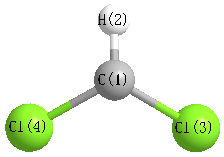Jump to
S1C2
Energy calculated at QCISD(T)/aug-cc-pVTZ
| | hartrees |
|---|
| Energy at 0K | -958.044511 |
| Energy at 298.15K | |
| HF Energy | -957.449292 |
| Nuclear repulsion energy | 125.711822 |
The energy at 298.15K was derived from the energy at 0K
and an integrated heat capacity that used the calculated vibrational frequencies.
Vibrational Frequencies calculated at QCISD(T)/aug-cc-pVTZ
| Mode Number |
Symmetry |
Frequency
(cm-1) |
Scaled Frequency
(cm-1) |
IR Intensities
(km mol-1) |
Raman Act
(Å4/u) |
Dep P |
Dep U |
|---|
| 1 |
A1 |
3265 |
3157 |
|
|
|
|
| 2 |
A1 |
753 |
728 |
|
|
|
|
| 3 |
A1 |
307 |
297 |
|
|
|
|
| 4 |
B1 |
412i |
398i |
|
|
|
|
| 5 |
B2 |
1231 |
1190 |
|
|
|
|
| 6 |
B2 |
928 |
897 |
|
|
|
|
Unscaled Zero Point Vibrational Energy (zpe) 3036.2 cm
-1
Scaled (by 0.9668) Zero Point Vibrational Energy (zpe) 2935.4 cm
-1
See section
III.C.1 List or set vibrational scaling factors
to change the scale factors used here.
See section
III.C.2
Calculate a vibrational scaling factor for a given set of molecules
to determine the least squares best scaling factor.
Geometric Data calculated at QCISD(T)/aug-cc-pVTZ
Point Group is C2v
Cartesians (Å)
| Atom |
x (Å) |
y (Å) |
z (Å) |
|---|
| C1 |
0.000 |
0.000 |
0.677 |
| H2 |
0.000 |
0.000 |
1.753 |
| Cl3 |
0.000 |
1.474 |
-0.171 |
| Cl4 |
0.000 |
-1.474 |
-0.171 |
Atom - Atom Distances (Å)
| |
C1 |
H2 |
Cl3 |
Cl4 |
| C1 | | 1.0760 | 1.7009 | 1.7009 |
H2 | 1.0760 | | 2.4240 | 2.4240 | Cl3 | 1.7009 | 2.4240 | | 2.9487 | Cl4 | 1.7009 | 2.4240 | 2.9487 | |
 More geometry information
More geometry information
Calculated Bond Angles
| atom1 |
atom2 |
atom3 |
angle |
|
atom1 |
atom2 |
atom3 |
angle |
| Cl3 |
C1 |
H2 |
119.912 |
|
Cl3 |
C1 |
Cl4 |
120.176 |
| Cl4 |
C1 |
H2 |
119.912 |
|
Electronic energy levels
Charges, Dipole, Quadrupole and Polarizability
Jump to
S1C1
Energy calculated at QCISD(T)/aug-cc-pVTZ
| | hartrees |
|---|
| Energy at 0K | -958.045614 |
| Energy at 298.15K | -958.046441 |
| HF Energy | -957.450929 |
| Nuclear repulsion energy | 125.549907 |
The energy at 298.15K was derived from the energy at 0K
and an integrated heat capacity that used the calculated vibrational frequencies.
Vibrational Frequencies calculated at QCISD(T)/aug-cc-pVTZ
| Mode Number |
Symmetry |
Frequency
(cm-1) |
Scaled Frequency
(cm-1) |
IR Intensities
(km mol-1) |
Raman Act
(Å4/u) |
Dep P |
Dep U |
|---|
| 1 |
A' |
3223 |
3116 |
|
|
|
|
| 2 |
A' |
764 |
739 |
|
|
|
|
| 3 |
A' |
524 |
506 |
|
|
|
|
| 4 |
A' |
302 |
292 |
|
|
|
|
| 5 |
A" |
1240 |
1199 |
|
|
|
|
| 6 |
A" |
896 |
867 |
|
|
|
|
Unscaled Zero Point Vibrational Energy (zpe) 3474.4 cm
-1
Scaled (by 0.9668) Zero Point Vibrational Energy (zpe) 3359.1 cm
-1
See section
III.C.1 List or set vibrational scaling factors
to change the scale factors used here.
See section
III.C.2
Calculate a vibrational scaling factor for a given set of molecules
to determine the least squares best scaling factor.
Geometric Data calculated at QCISD(T)/aug-cc-pVTZ
Point Group is Cs
Cartesians (Å)
| Atom |
x (Å) |
y (Å) |
z (Å) |
|---|
| C1 |
0.013 |
0.704 |
0.000 |
| H2 |
-0.504 |
1.652 |
0.000 |
| Cl3 |
0.013 |
-0.173 |
1.470 |
| Cl4 |
0.013 |
-0.173 |
-1.470 |
Atom - Atom Distances (Å)
| |
C1 |
H2 |
Cl3 |
Cl4 |
| C1 | | 1.0795 | 1.7113 | 1.7113 |
H2 | 1.0795 | | 2.3991 | 2.3991 | Cl3 | 1.7113 | 2.3991 | | 2.9394 | Cl4 | 1.7113 | 2.3991 | 2.9394 | |
 More geometry information
More geometry information
Calculated Bond Angles
| atom1 |
atom2 |
atom3 |
angle |
|
atom1 |
atom2 |
atom3 |
angle |
| Cl3 |
C1 |
H2 |
116.729 |
|
Cl3 |
C1 |
Cl4 |
118.371 |
| Cl4 |
C1 |
H2 |
116.729 |
|
Electronic energy levels
Charges, Dipole, Quadrupole and Polarizability
